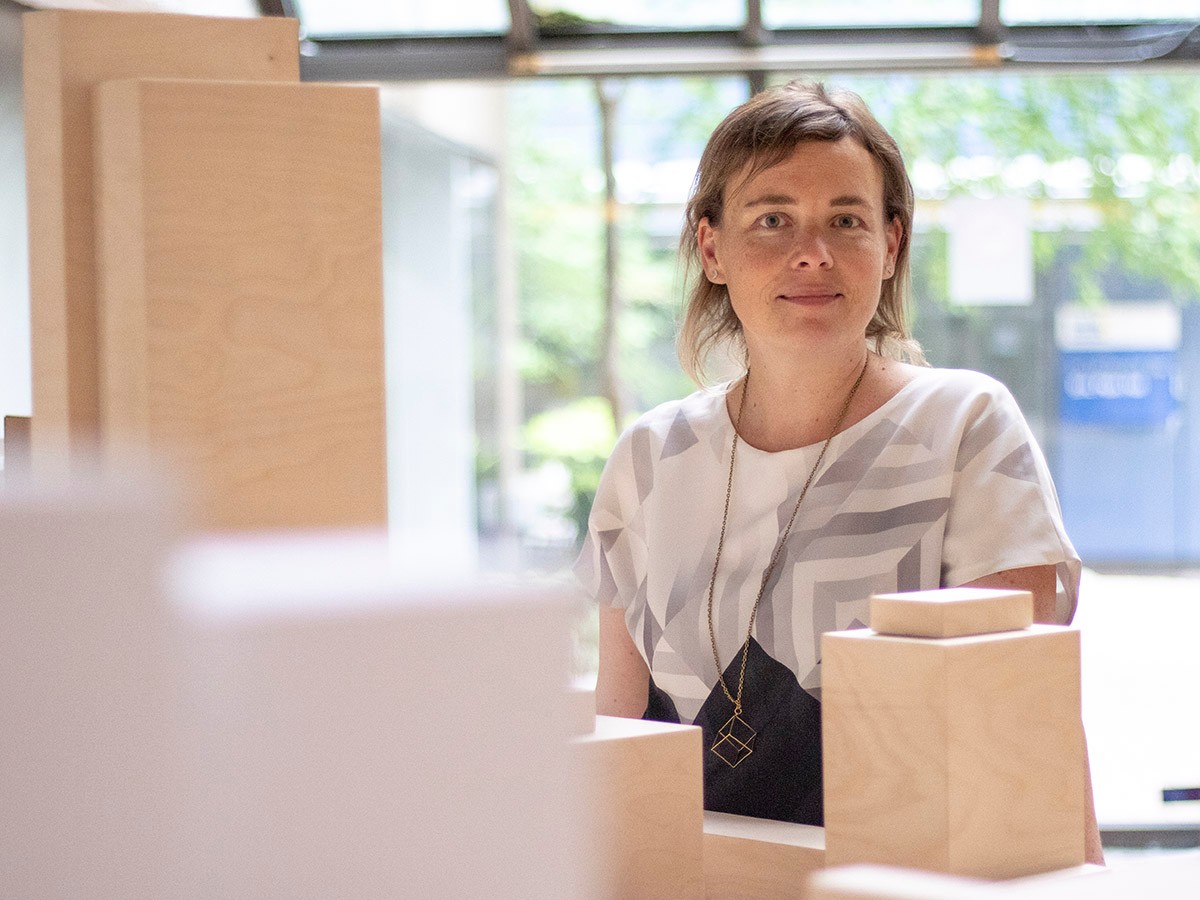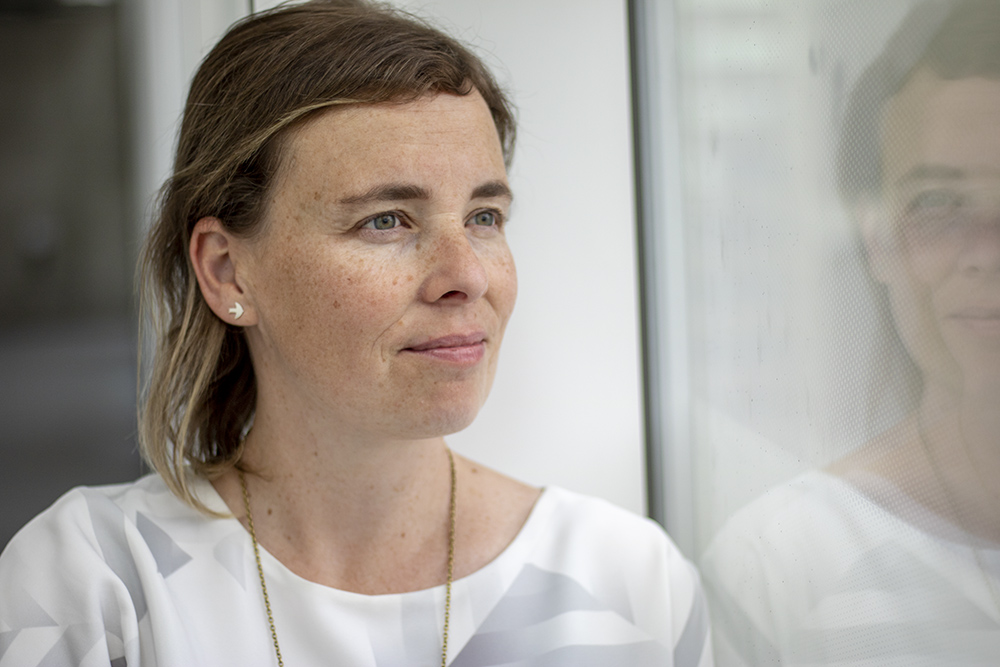Dr. Terri Peters

Areas of Specialization
Architectural design
Architectural pedagogy
Daylighting
Design for health
Healthy housing
Resilient environments
Social sustainability
Education
| Year | University | Degree |
|---|---|---|
| 2015 | Aarhus Architecture School | PhD |
| 2008 | Kingston University | PGDip Arch/ RIBA III |
| 2006 | London Metropolitan University | DipArch/ RIBA II |
| 2002 | Dalhousie University | BEDS |
| 2000 | University of Victoria | BA |
Spotlight
Terri Peters has long been interested in the effects of building performance on well-being; but when she lived in Copenhagen, she experienced it firsthand. Design there was different, especially in the medium-rise housing blocks that many, including Peters herself, called home. Instead of the long, dark condos that are typical of North America, balconies facing sunny courtyards were common, as was a focus on hygge, meaning coziness. “In Denmark,” she says, “quality of life is most important.”
It’s important for Peters, too. Much of her research focuses on superarchitecture: where design is driven by what adds to our health, such as wide-open views, good air flow, maximized daylight and access to the outdoors. Here in Canada, Peters wants superarchitecture to play more of a central role. However, as many of these elements are not quantitative—i.e. how do you measure that calm feeling you get from a well-lit room?—there are challenges.
To overcome them, Peters is researching strategies that benefit both our natural environment and our well-being, like appropriate uses of daylight and testing design options via digital simulation. She’s also speaking up at various health-related conferences. “The more architects who advocate, the healthier our buildings will be.”

“Our buildings can make us better—if we let them.”
- 2024-2026 Center for Learning and Teaching (CELT) TMU Teaching Fellow
- 2023 AVP International's Global Learning Award
- 2021 National Center for Faculty Development & Diversity (NCFDD): Faculty Success Program 2021.
- 2020 University Teaching Development Program (UTDP) SEDA UK.
- A. Boissonneault, T. Peters. An Exploration of Post-Occupancy Evaluation in Canada: Origins, milestones and next steps, Building Research and Information. 2023. DOI: 10.1080/09613218.2023.2192905
- T. Peters, S. Masoudinejad. Balconies as Dynamic Spaces in Adaptable Apartment Housing, Buildings & Cities. 3(1), 2022. pp. 265–278. https://doi.org/10.5334/bc.191
- T. Peters, S. Verderber. Biophilic Design Strategies in Long-Term Residential Care Environments for Persons with Dementia, Journal of Aging and Environment, 2021. https://doi.org/10.1080/26892618.2021.1918815
- T. Peters. The Social Contexts of Resilient Architecture in Multisystemic Resilience: Adaptation and Transformation in Contexts of Change, M. Ungar Ed. Oxford University Press, 2021, p.625-681. ISBN: 978-0190095888.
- Peters T, Alkhalli N*, Kesik T, O'Brien L. (2020) Metrics And Methods For Climate-based Daylight Simulations Of Multi-Unit Residential Buildings. 2020 Building Performance Analysis Conference and SimBuild, September 29- October 1 2020, Chicago, Illinois, Chicago, United States
- T. Peters, A. Halleran. How our Homes Impact our Health: Using a COVID-19 Informed Approach to Examine Apartment Housing, Archnet-International Journal of Architectural Research, Vol. 15(1), 2020, p.10-27. https://doi.org/10.1108/ARCH-08-2020-0159,
- T. Kesik, L. O'Brien, T. Peters. Enhancing the Liveability and Resilience of Multi-Unit Residential Buildings (MURB): MURB Design Guide, Version 2.0, 2019. https://pbs.daniels.utoronto.ca/faculty/kesik_t/PBS/Kesik-Resources/MURB-Design-Guide-v2-Feb2019.pdf
- S. Coleman, M. Touchie, J. Robinson, T. Peters. Rethinking Performance Gaps: A Regenerative Sustainability Approach to Built Environment Performance Assessment. Sustainability. 2018. 10(12) 4829. https://doi.org/10.3390/su10124829
- Peters T., Peters B. (2018) Computing the Environment: Digital Design Tools for Simulation and Visualisation of Sustainable Architecture, (Chichester: John Wiley & Sons). ISBN: 978-1-119-09789-1
- Peters T, Editor, (2017) Special Issue: Design for Health: Sustainable Approaches to Therapeutic Architecture. Architectural Design, Chichester: John Wiley & Sons, March/April 2017). ISBN: 978-1-119-16213-1
- Registered Architect in the UK 2008-present
- WELL AP Certification 2019-present
- Article: "High Rise Habitats 55 Years Later" Canadian Architect, November 2020 page 47-49. Coauthored with Dr Ted Kesik at University of Toronto.
https://www.canadianarchitect.com/high-rise-habitats-55-years-later/ (external link) - Presentation: "Rethinking Liveability in the Design and Development of Multi-Unit Housing" 7th Active House Symposium, Brickworks Toronto 16-17 September 2019, Toronto, Canada https://www.activehouse.ca/speakers/terri-peters/ (external link)
- Invited workshop: “Superarchitecture”, Canadian Institute for Advanced Research (CIFAR) Interdisciplinary Workshop on Multi-Systemic Resilience, led by Dr Michael Ungar, Johannesburg, South Africa 2017.
- 2023 “Benchmark 2023: Future Forward—Adaptive Change in Architecture Education and Practice” Canadian Architect, November 2023, page 46-49. Coauthored with Dr Ted Kesik at University of Toronto. https://www.canadianarchitect.com/benchmark-2023-future-forward-adaptive-change-in-architecture-education-and-practice/
- 2023 Presentation: “New Approaches to Long Term Care Design” in the session: “Un-Exposed: Co-Creating New Models for Care, Community, Wellness, and Dignity” OAA Conference Designing for Dignity 2023. Sudbury, Ontario. June 23 2023
- 2022 Presenter: “Workshop: Design for Healthy Aging: Solutions Across the Continuum of Care” August 17-18 2022 The Center for Health Design. https://www.healthdesign.org/events/429
- 2021 “What Makes Architecture Excellent? Prioritizing People, Place, and Purpose." Architect, September 2021 p.64-77. https://www.architectmagazine.com/design/what-makes-architecture-excellent-today_o
- 2020 "High Rise Habitats 55 Years Later" Canadian Architect, November 2020 page 47-49. Coauthored with Dr Ted Kesik at University of Toronto.
https://www.canadianarchitect.com/high-rise-habitats-55-years-later/ - 2020 Conference Presentation: Royal Architectural Institute of Canada (RAIC) Conference, Academic Summit. “Healthier and Happier: Designing for Wellbeing and Daylight” Edmonton, July 9, 2020.
- 2019 Presentation: "Rethinking Liveability in the Design and Development of Multi-Unit Housing" 7th Active House
- Symposium, Brickworks Toronto 16-17 September 2019, Toronto, Canada
- 2019 Keynote: “Superarchitecture: Daylight as a Driver for Change” at 7th Annual VELUX Daylight Symposium, May 3-4, Berlin Germany. http://thedaylightsite.com/symposium/2019-2/
- Invited workshop: “Superarchitecture”, Canadian Institute for Advanced Research (CIFAR) Interdisciplinary Workshop on Multi-Systemic Resilience, led by Dr Michael Ungar, Johannesburg, South Africa 2017.